
The Solar-Terrestrial Centre of Excellence (STCE) is a collaborative network of the Belgian Institute for Space Aeronomy, the Royal Observatory of Belgium and the Royal Meteorological Institute of Belgium.
 |
Published by the STCE - this issue : 21 Aug 2015. The Solar-Terrestrial Centre of Excellence (STCE) is a collaborative network of the Belgian Institute for Space Aeronomy, the Royal Observatory of Belgium and the Royal Meteorological Institute of Belgium. |
| Archive of the newsletters | Subscribe to this newsletter by mail |
Last week, at the General Assembly of the International Astronomical Union in Honolulu (Hawaii), the standardization of the sunspot number was publicly announced. IAU called the sunspot number the 'longest ongoing scientific experiment' and this dataset is therefore the key to track the evolution of the Sun. Given its fundamental nature, the sunspot number series is broadly used in astrophysics (stellar evolution) and the long-term impact of solar evolution on life on Earth.
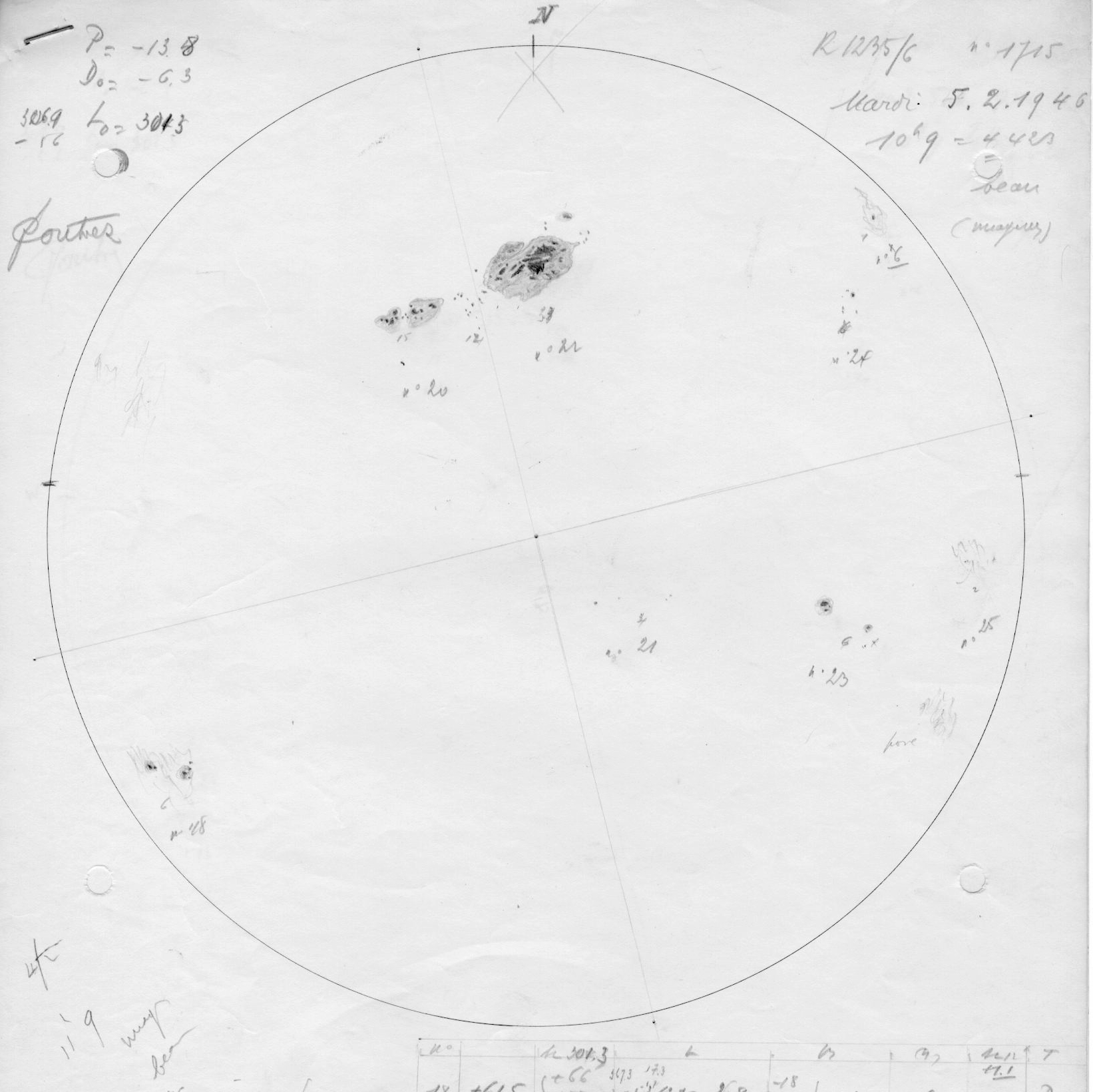
Tracking the sunspot number stretches back to the first telescopes used by Galileo Galilei and has had over the last four centuries a lively history of varying observers, calculation procedures and calibration decisions. Since 1981, the production and the maintenance of the sunspot number is managed at the Royal Observatory of Belgium by the World Data Center, now led by Dr. Frederic Clette. New sunspot observations arrive in Brussels from an international network of both professionals and amateur observers, to continuously extend the sunspot number series.
As with the renovation of an old painting, Dr. Clette and his international partners carefully studied all efforts and procedures that had been previously applied to maintain stability over centuries. By comparing with related data sets, they identified which of the past procedural or observational changes had inappropriate effects on the sunspot number. Removing these and stitching together data from periods in history and from different observatories, they arrived at a new, more coherently standardized sunspot number data set.
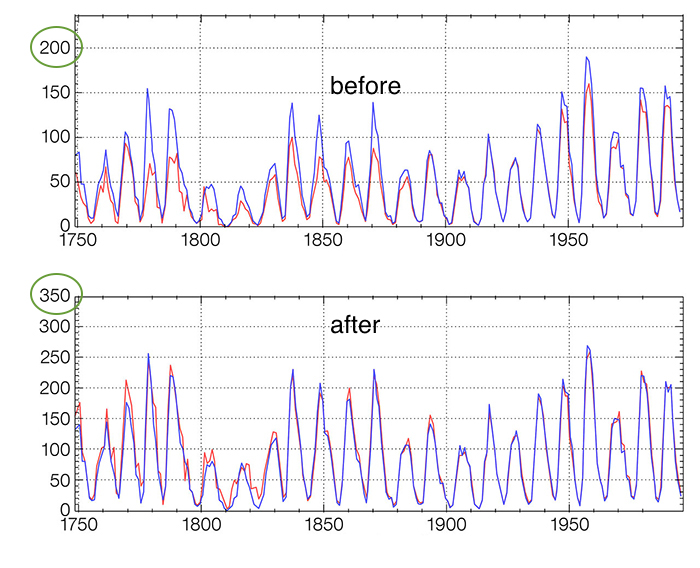
The well reputed scientific magazine Nature called this a hot topic which, given the intense public interest in solar forcing and climate, is likely to be carefully scrutinized. It is remarkable that the sunspot number data series, with a particular need for long-term investment and based partially on amateur observations, has maintained its unique position in this era of giant space telescopes and short-term project funding of science.
SILSO, Sunspot Index and Long-term Solar Observations ( http://sidc.be/silso/home ) is the World Data Center for the production, preservation and dissemination of the international sunspot number, as recognized by International Council for Science ( http://www.icsu.org ) . It is hosted at the Royal Observatory of Belgium ( http://www.astro.oma.be ) . The activities of SILSO are supported by the Solar-Terrestrial Center of Excellence .
IAU press release http://www.iau.org/news/pressreleases/detail/iau1508/
Nature News item http://www.nature.com/news/spotty-sunspot-record-gets-a-makeover-1.18145
Solar flare activity fluctuated between very low and low during the week.
To view the the weeks activity in more detail, we suggest you visit: http://proba2.oma.be/ssa from which all the daily (normal and difference) movies can be accessed. This page also lists the recorded flaring events.
A weekly overview movie can be found here: http://proba2.sidc.be/swap/data/mpg/movies/weekly_movies/weekly_movie_2015_08_10.mp4 (SWAP week 281).
No major flares occurred this week, the strongest flare was a C1.9 flare on 2015-08-14 at 02:00 UT. However, a well observed filament eruption occurred in the South-West quadrant, on 2015-08-12 around 13:30 UT. Below we provide an annotated SWAP image highlighting the event.
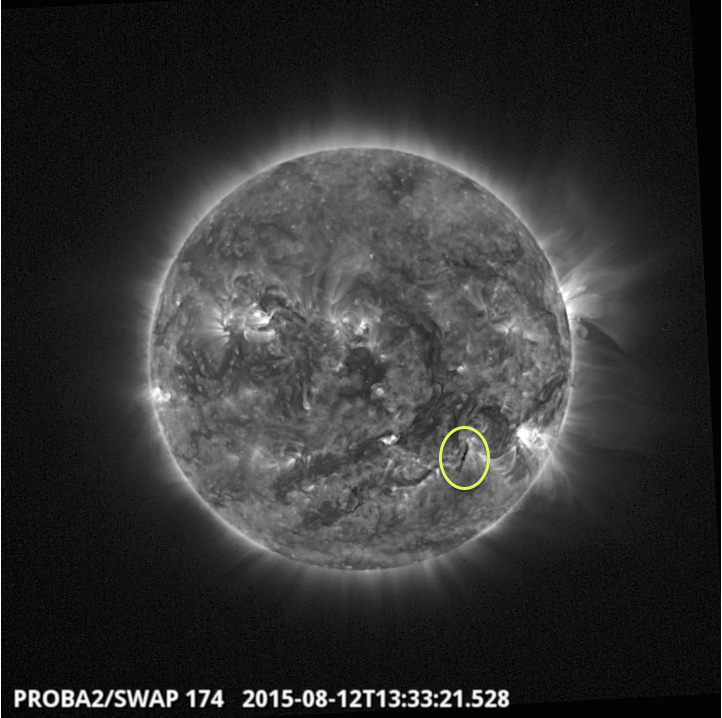
During this week only 6 low C-class flares were reported by GOES, five of them originating from the NOAA AR 2401 and one from the NOAA AR 2396. The strongest one was the C1.9 flare (peaked at 02:00 UT) on August 14, which originated from the NOAA AR 2401.
The image from SDO HMI shows AR 2396 ready to turn over the west limb and AR 2401 on the eastern part of the solar disk.
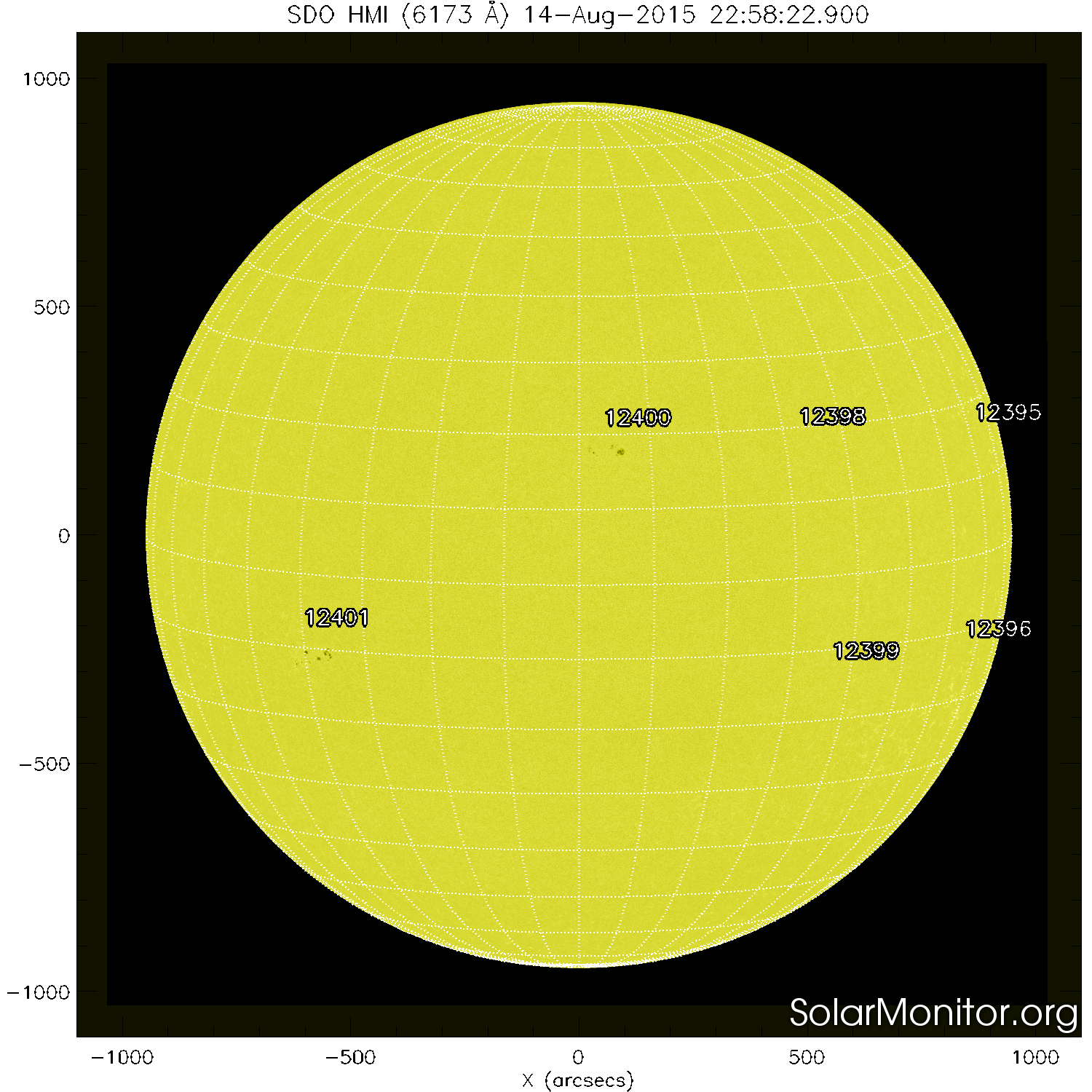
Two wide CMEs were observed this week, both of them partial halo CMEs.
The first partial halo CME was first seen in the SOHO LASCO C2 field of view at 14:48 UT, on August 12. The CME was associated with the B7.0 flare (peaked at 15:26 UT) originating from the bipolar region situated in that moment at about S20 W35 and with the filament eruption. A coronal dimming was noticed. The CME had an angular width of about 190 degrees and the projected plane of the sky speed of about 450 km/s according to the CACTus (Computer Aided CME Tracking) software. The bulk of the CME mass was directed somewhat southward of the Sun-Earth line, however the CME and the CME-driven shock wave arrived at the Earth on August 15 (see white dotted line in the ACE graph - black background).
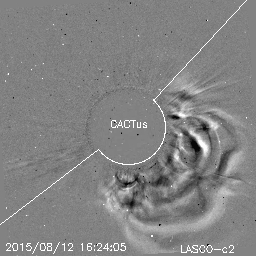
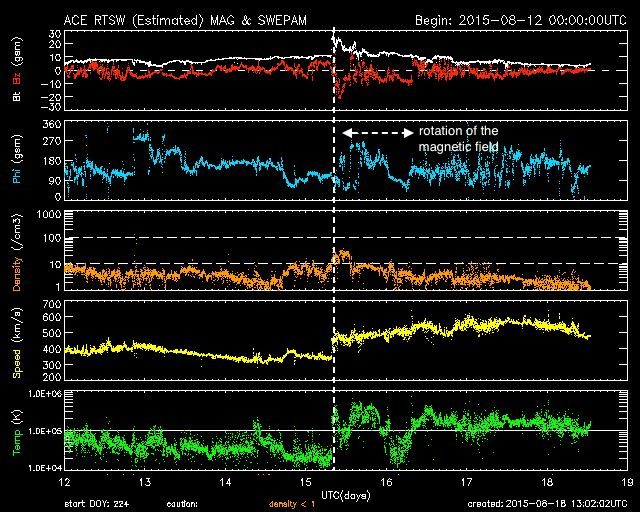
Second partial halo CME observed this week was first seen in the SOHO LASCO C2 field of view at 09:36 UT on August 14. The CME was associated with the filament eruption from the southwest quadrant, had angular width of about 140 degrees and the projected plane of the sky speed of about 200 km/s according to the CACTus software. The bulk of the CME mass was directed southward of the Sun-Earth line.
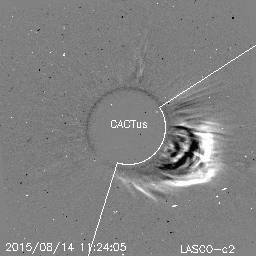
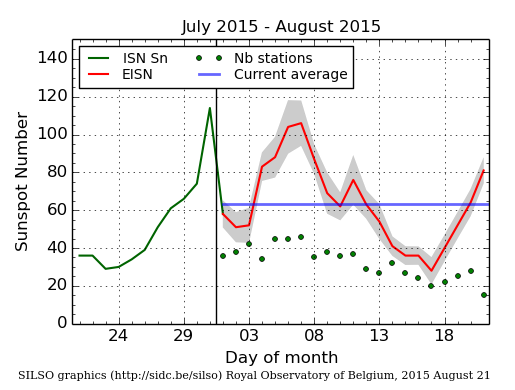
Daily Estimated International Sunspot Number (EISN, red curve with shaded error) derived by a simplified method from real-time data from the worldwide SILSO network. It extends the official Sunspot Number from the full processing of the preceding month (green line). The plot shows the last 30 days (~ one solar rotation). The horizontal blue line shows the current monthly average, while the green dots give the number of stations included in the calculation of the EISN for each day.
From Aug 11, Earth was inside of a slow solar wind. In the morning of August 15, 07:30 UT, the satellite ACE situated at the L1 point recorded the shock associated with the partial halo CME from August 12.
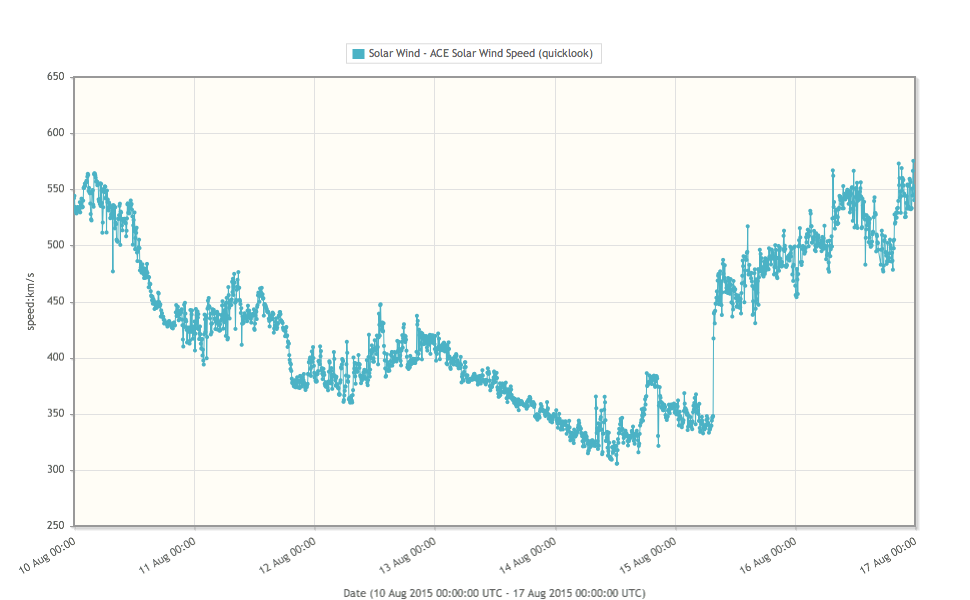
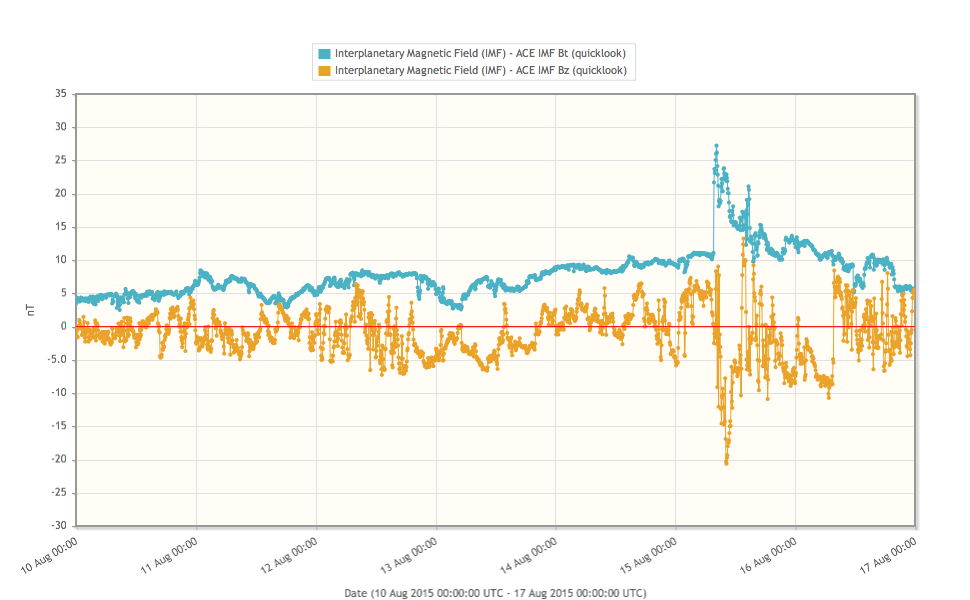
The solar wind speed jumped from 350 to 450 km/s, and the interplanetary magnetic field reached 28 nT. The Bz component of the interplanetary magnetic field went down to -20 nT. This strong southward field initiated a geomagnetic storm, NOAA reported Kp=7 and the local stations Dourbes and IZMIRAN reported K=5. The ICME following the shock had a speed of 550 km/s and carried a negative Bz component (up to -10nT) and dumped as such energy in the earth magnetosphere leading to the continuation of the geomagnetic storm that started with the passage of the shock at ACE. On the morning of August 16, NOAA reported Kp=6 and Dourbes and IZMIRAN reported K=5.
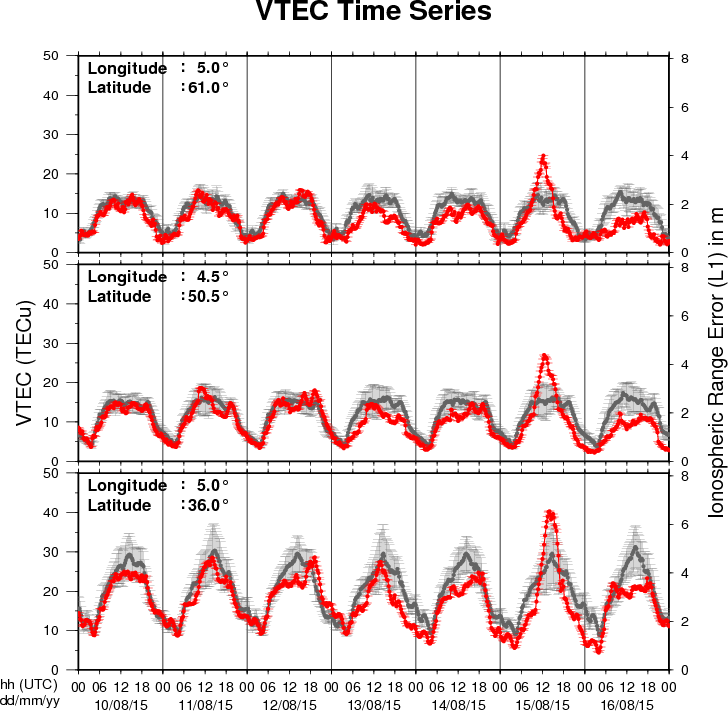
The figure shows the time evolution of the Vertical Total Electron Content (VTEC) (in red) during the last week at three locations:
a) in the northern part of Europe(N61°, 5°E)
b) above Brussels(N50.5°, 4.5°E)
c) in the southern part of Europe(N36°, 5°E)
This figure also shows (in grey) the normal ionospheric behaviour expected based on the median VTEC from the 15 previous days.
The VTEC is expressed in TECu (with TECu=10^16 electrons per square meter) and is directly related to the signal propagation delay due to the ionosphere (in figure: delay on GPS L1 frequency).
The Sun's radiation ionizes the Earth's upper atmosphere, the ionosphere, located from about 60km to 1000km above the Earth's surface.The ionization process in the ionosphere produces ions and free electrons. These electrons perturb the propagation of the GNSS (Global Navigation Satellite System) signals by inducing a so-called ionospheric delay.
See http://stce.be/newsletter/GNSS_final.pdf for some more explanations ; for detailed information, see http://gnss.be/ionosphere_tutorial.php
Start : 2015-08-22 - End : 2015-08-23
On August 21, 2017, a total eclipse of the Sun will cross the
United States from coast to coast, giving tens of millions of
people in a 70-mile-wide path from Oregon to South Carolina a
chance to see the solar corona and experience "darkness at midday."
Outside the path of totality, all of North America will experience
a partial eclipse. This event, the first total solar eclipse to
touch the US mainland since 1979 and the first to span the
continent since 1918, presents a unique opportunity to excite
people about science and connect them personally to the cosmos, as
well as to conduct several important scientific observations. We
are a working group dedicated to the science and public outreach of
this unique event.
The next Eclipse 2017 workshop will take place in Portland,
Oregon, on Saturday and Sunday, August 22 and 23, 2015, at the
Oregon Museum of Science and Industry, hosted by the director Jim
Todd. Saturday's morning session will be open to the public at
large, with presentations to inform the public about the total
solar eclipse of 2017. The Saturday afternoon and Sunday sessions
will follow a schedule similar to those at previous workshops with
presentations alternating with smaller group discussions, and a
final presentation of small group results.
Website:
https://aas.org/education/outreach/eclipse-2017
Start : 2015-08-24 - End : 2015-08-28
Following the success of previous CESRA summer schools, Glasgow
University is hosting the 2015 CESRA radio summer school on the
24-28th August 2015. The Glasgow CESRA Summer School 2015 is your
chance to learn about the exciting world of solar radio
physics.
The school is open to solar radio physicists including PhD
students and early career researchers. The school will cover the
essential elements of theory, modelling and data analysis and will
feature lectures and tutorials. Students will have the opportunity
to meet and discuss research topics with their peers together in an
informal atmosphere.
Website:
http://www.astro.gla.ac.uk/cesra2015
Start : 2015-10-26 - End : 2015-10-29
Erupting prominences/filaments, surges, flares, and coronal mass
ejections (CMEs) are prominent examples of the dynamic Sun.
Multi-wavelength and multi-instrument observations have the
potential to reveal highly energetic physical processes on the Sun
reaching from the photosphere, over the chromosphere and the
transition region, to the corona and beyond. Solar physicists have
nowadays access to a suite of new ground-based observing facilities
including, for example, the 1.5-meter GREGOR solar telescope at the
Observatorio del Teide, Tenerife, Spain, the European Low Frequency
Array (LOFAR), the Atacama Large Millimeter/Submillimeter Array
(ALMA) in Chile, and the Coronal Multi-Channel Polarimeter for
Slovakia (COMP-S) at Lomnicky Peak Observatory. A powerful fleet of
space missions, for example, the Reuven Ramaty High Energy Solar
Spectroscopic Imager (RHESSI), the Japanese Hinode, and the Solar
Dynamics Observatory (SDO), adds more capabilities to investigate
magnetic fields, complex plasma flows, and accelerated particle,
and thermal properties of solar eruptive events. In the tradition
of the series of »Potsdam Thinkshops«, we
invite instrument specialists, observers, modellers, and theorists
to exchange ideas, to stimulate discussion, to initiate future
collaborations among participants, and to attract new users of
instruments by showcasing the capabilities. The aim is to make
progress towards a comprehensive description of solar eruptive
events effectively aggregating their global properties as well as
their highly dynamic fine structure. Thinkshop 12 takes place at
the science park »Albert Einstein«, home to
AIP's Great Refractor and the Solar Observatory Einstein Tower at
the Telegraphenberg.
Website:
https://thinkshop.aip.de/12/cms/
Start : 2015-10-26 - End : 2015-10-29
The IRIS-5 workshop will be conducted at the Inter-University
Centre for Astronomy and Astrophysics (IUCAA), Pune, India from
October 26-29, 2015. This workshop is mainly aimed at the
participants who could not attend IRIS-4, which is being held at
Boulder, USA. Therefore, set up of the IRIS-5 workshop would be
essentially be very similar to that of IRIS-4.
The main aim of the workshop is to introduce the Interface
Region Imaging Spectrometer (IRIS) to students and young post docs.
This would be done through tutorials on IRIS data analysis, physics
of optically thick radiative transfer, MHD simulations of the solar
atmosphere related to IRIS and hydrodynamic simulations of flares.
There will be lectures as well as hands on sessions.
Website:
http://www.iucaa.ernet.in/~solar/Welcome.html
Start : 2015-11-09 - End : 2015-11-11
The fundamentally most important source of inner heliospheric
plasma physics and space weather is the active Sun, its solar
active region eruptions. Prediction of the evolution and influence
of solar active regions on solar storms in the near-Earth
environment is of particular interest to several forecasting
institutions, industrial stakeholders, and the public in
general.
State-of-the-art solar storm prediction tools are limited to
monitoring solar active regions, registering eruptions and mass
ejections while attempting, then, at extrapolating subsequent
evolution and spatio-temporal propagation: no realistic
physics-based and data-driven synthesis tool exists, which is
capable of predicting when a solar flare will be triggered, or when
a Coronal Mass Ejection will be launched into inter-planetary
space. In short, we are not yet able to answer the question: When
and why do solar storms launch?
Our meeting will be focused around initiation of space weather
events at the Sun. We will discuss and develop three major
challenges, and we aim to develop a draft resolution road-map for
those challenges during the meeting.
Website:
https://indico.nbi.ku.dk/conferenceDisplay.py?confId=817
Start : 2015-11-13 - End : 2015-11-13
With the launch of NASA's Solar Dynamics Observatory (SDO)
mission on 02/11/2010, researchers in solar physics have entered
the era of Big Data. The Atmospheric Imaging Assembly (AIA)
instrument on SDO provides imaging data and the Helioseismic and
Magnetic Imager (HMI) instrument on SDO provides magnetic field
data. Both instruments record data at a high spatial resolution and
a time cadence, amounting to about 1 Petabyte of scientific data
each year. The Big Data challenges in Solar Astronomy are expected
to grow even further with the inauguration of the NSF funded Daniel
K. Inouye Solar Telescope (DKIST), currently under construction in
Hawaii. This telescope is expected to generate: 3-5 Petabytes of
data per year.
Start : 2016-06-27 - End : 2016-07-01
Website:
http://www.issibern.ch/program/workshops.html
The STCE Annual Report 2013 is a compilation of the activities done in 2013 within the frame of the Solar-Terrestrial Centre of Excellence (STCE). This report continues the style from the previous edition. Hence, as it is targeting a more general public, it presents only a selection of the 2013-activities in easy-to-digest summaries. These summaries emphasize the intense collaboration between the institutes at the Space Pole, as well as with our external partners. We hope you enjoy this report, which features articles on solar and space weather activity, the Open Doors at the Space Pole, the 10th European Space Weather Week, a new value for the solar constant, quality assessment of ozonesonde data, BRAMS, PICASSO, ionospheric monitoring, and much more... Happy reading!
http://www.spaceweather.eu/en/repository/show?id=584
Application for the annual prize Science Communication awarded by the Koninklijke Vlaamse Academie van België voor Wetenschappen en Kunsten.
http://www.spaceweather.eu/en/repository/show?id=585
Report on the eHEROES deliverable 'Hitchhikers' guide to space'.
http://www.spaceweather.eu/en/repository/show?id=586
Report on the first period of the FP7 project eHEROES
http://www.spaceweather.eu/en/repository/show?id=587
Report of the second and final period of the FP7 project eHEROES
http://www.spaceweather.eu/en/repository/show?id=588
Report on the eHEROES deliverable 'The Space Weather News'.
http://www.spaceweather.eu/en/repository/show?id=589
Report on the FP7 project eHEROES deliverable Information and Education
http://www.spaceweather.eu/en/repository/show?id=590
Report on the FP7 project eHEROES summer school
http://www.spaceweather.eu/en/repository/show?id=591